-
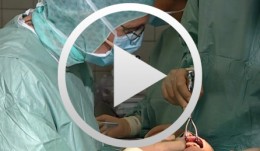

Gestieltes Bindegewebstransplantat bei verzögerter Sofortimplantation
Wagner, WilfriedGliederung - Implantatinsertion mit Bohrschablone - Gestieltes Bindegewebstransplantat Inhalt: Zur Verbesserung der ästhetischen Voraussetzungen kann im Zusammenhang mit der Implantation eine Weichgewebeaugmentation mit einem palatinal gestielten Bindegewebstransplantat erfolgen. Das sichert gleichzeitig die Wundabdeckung bei einer submukösen Einheilung und kommt ohne zusätzliche ästhetisch störende vestibuläre Entlastungsinzisionen aus. In die ehemalige Extraktionsalveole des Zahnes 21 wird ein Nobel Biocare-Relace-Implantat eingebracht. Mit der vorbereiteten Bohrschablone erfolgt eine Orientierung an der palatinalen Alveolenwand, um den vestibulären Knochen nicht zu schädigen. Nach stabilem Einbringen des Implantates wird dann auf der gleichen Seite durch palatinale Inzision ein freies Bindegewebe transplantiert. Es ist mesial gestielt und wird stabil über die Implantatregion nach vestibulär mit einem Vicrylfaden eingenäht. Um die ästhetische Weichteilkonturierung nach Einheilung des Implantates zu erleichtern, wird das Weichgewebe im Überschuss augmentiert. -
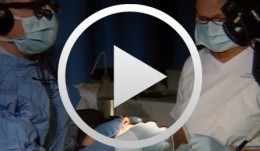

Rubber Dam - a Practical Exercise
Lambrechts, PaulContents: Demonstration of rubber dam application. -
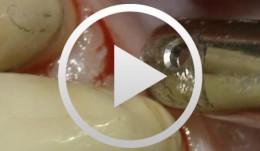

Access-Flap for Treatment of Aggressive Periodontitis
Beck, FrankContents. Aggressive periodontitis leads to early and extensive loss of periodontal supporting tissue. Controlling the infection is of serious importance to avoid further loss of attachment. The surgical procedure is difficult, especially if the tissue is already severely damaged. The challenge for the surgeon is to protect and conserve the tissue as much as possible. -
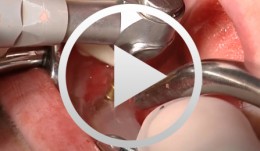

Implant-borne Immediate Prothesis on Laser-Welded Bar
Drobig, FelixDescription of baseline situation; Exposure of underlying bone; Insertion of four implants; Impression-taking; Bar construction; Welding the individual components, Correction of tension; Finishing the bar; Adjusting the prosthesis; Implant placement. -


Bone Transfer
Streckbein, RolandContent: Description of system and instruments. The patient had a considerable bone deficit at tooth 21. Augmentation was therefore required and was carried out using calibrated instruments. The augmentation site was prepared using instruments that matched the tools used to harvest the cylindrical bone graft at the donor site. This perfect match between the augmentation region and the bone transplant accelerated osseointegration, there by shortening the required waiting time for implant placement. -
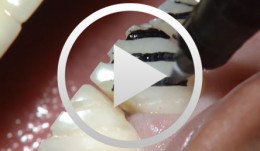

Restoration of Anterior Teeth with Porcelain laminate Veneers
Bastek, Siegfried / Fiechter, PaulContent: Preparation of teeth; Composite build-up for larger lesions; Smoothing of preparation surfaces; Placement of retraction cords; Impression-taking with A-silicone; Placement of temporary; Preparation of model; Preparation of laminate veneers; Final adhesive bonding of laminate veneers. -
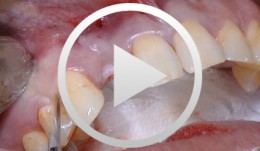

Combined implant treatment with soft and hard tissue management
Schlee, MarkusProcedure - Soft and hard tissue management - Implantodontic treatment - Case documentation Contents: - History - Patient hadn't seen a dentist for 15 years - Has been on Marcumar since developing a blood clot in 1997 - His general practitioner extracted teeth and performed conservative dentistry during the last year - Heavy smoker (30 cigarettes a day) - Prothrombin time (Quick's value): 40 - Premedication: Augmentan 750/125 tablets. -
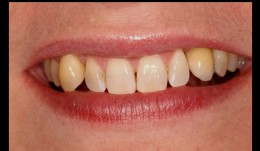

Periodontitis case, smoker, single anterior implant crown
Prof N. P. Lang and M. Lulic.Female patient *1966, by M. Lulic and N. P. Lang (2007-2008). Periodontitis case with pain, smoker, single anterior implant crown. -
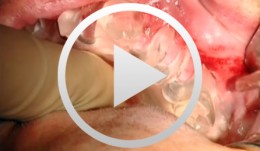

Sinus Bone Augmentation with PRP
Schultze-Mosgau, StefanContents - Incision technique for lateral sinus floor augmentation - Creation of a lateral bone window in the facial maxillary sinus wall - Maxillary sinus floor elevation - Chin bone graft harvesting - Retromolar bone harvesting - Sinus floor augmentation using autologous bone, beta- tricalcium phosphate (1:1) and PRP Synopsis: Maxillary sinus augmentation may be indicated in cases where it is desirable to increase the vertical bone stock in the upper lateral tooth region. Maxillary sinus floor augmentation entails the implantation of autologous bone or bone replacement material in the spaces between the bony floor and elevated membrane of the maxillary sinus. This video demonstrates the techniques for palatal incision, access preparation, and exposure of the facial wall of the maxillary sinus. A diamond drill is used to create a bony window in the facial wall of the maxillary sinus taking care not to perforate the sinus membrane. After completely detaching the basal parts of the membrane, the flap is advanced cranially using angular elevation instruments. Regarding the procedure for autologous bone grafting, the steps for incision, prepping and harvesting of monocortical chin bone transplants with a trephine drill are demonstrated. An alternative procedure for harvesting retromolar bone material is also shown. A bone mill is used to particulate the autologous bone material. The autologous bone chips are then mixed 1:1 with beta-tricalcium phosphate (and PRP) and inserted in the sinus floor. -
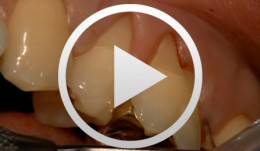

Regenerative Therapy for Multiple Recessions
Heinz, BerndContents - History - Emdogain Application - Incision - Periosteal Incision - Root Smoothing - Suture Technique - PrefGel Application Synopsis: Regenerative periodontal surgery with Emdogain enamel matrix protein: The goal of regenerative periodontal surgery is to rebuild destroyed periodontal structures. Bone transplants, bone replacement materials, and nonresorbable and resorbable membranes have been and still are being used. In a new therapeutic approach to periodontal regeneration, the root surface is conditioned using an enamel matrix protein derivative (Emdogain, Biora). The protein complex stimulates the regeneration of root cement, which in turn leads to the regeneration of bone and collagen fibers. Since the early 1980's, Professor Lars Hammerström's Swedish research team has performed extensive research and studies on this method and its mode of action. Emdogain is now used for treatment of vertical bone defects and furcation defects. The exposed root surface is first carefully scaled using handheld instruments or a rotating, fine-grain diamond drill. PrefGel EDTA suspension (Biora) is then applied for 2 minutes, then thoroughly rinsed with physiological saline solution. The EDTA suspension serves to remove the smear layer and opens the dentinal tubules, leading to improved binding of Emdogain to the root surface. Emdogain is applied to the blood- and saliva-free root surface immediately after rinsing. Finally, the wound is sutured closed. -
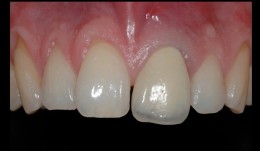

Replacement of central incisor with implant and closure of diastema
PD Dr. Ronald JungThe broken central incisor 21 was replaced with an implant-supported crown. The diastema could be closed with an etch-piece on 11. -
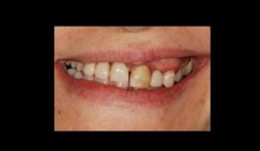

Replacement of poorly fitting removable prosthesis and simultaneous orthodontic treatment
Dr. Dominik BüchiThis patient (*1971) treated by Dr. Büchi, came to our clinic for a replacement of her poorly fitting removable prostheses. Additionally severe orthodontic problems, i.e. a slanting occlusion plane are bothering the patient and are in need of treatment.










